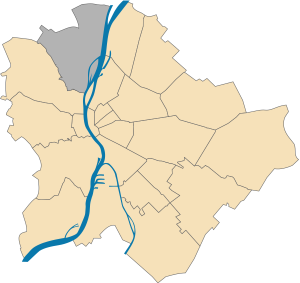Óbuda-Békásmegyer, or Budapest’s III. district, is a captivating blend of ancient history and contemporary charm. Located on the western bank of the Danube, this district offers tourists a unique experience, from Roman ruins to vibrant festivals.
Location

Óbuda-Békásmegyer, the III. district of Budapest, enjoys a strategic location on the western bank of the Danube River. To its east, the shimmering waters of the Danube provide a natural border, offering picturesque views and riverside activities. The district encompasses the Óbudai-sziget, a significant island that’s a hub for festivals and recreation. To the west, the district extends into the foothills of the Budai-hegység and Pilis, providing a natural escape with scenic trails and panoramic vistas. Its proximity to the city center, combined with its natural beauty, makes Óbuda-Békásmegyer a sought-after destination for both residents and tourists.
Geography
The district’s picturesque location by the Danube is complemented by the Óbudai-sziget (Óbuda Island), a hub of recreational activities. The district’s diverse geography, ranging from flat terrains to the foothills of the Budai-hegység and Pilis, offers scenic views and nature trails.

History
The district’s historical significance is evident in Aquincum, the ancient Roman city that once stood as the capital of the Pannonia province. With well-preserved ruins, baths, and amphitheaters, Aquincum offers a window into the district’s Roman past.
Landmarks & Attractions
- Aquincum Museum: Dive deep into Roman history with artifacts, ruins, and interactive exhibits.
- Óbudai-sziget (Óbuda Island): Beyond its fame for the Sziget Festival, the island is a haven for picnics, walks, and relaxation.
- Zichy-kastély: This castle, with its baroque architecture, hosts cultural events, art exhibitions, and provides a glimpse into Hungary’s aristocratic past.
- Magyar Kereskedelmi és Vendéglátóipari Múzeum: A unique museum showcasing Hungary’s trade and catering evolution.
Demographics
As of 2022, Óbuda-Békásmegyer boasts a diverse population of 128,827 residents. The district’s rich history and modern amenities make it a melting pot of cultures, attracting both locals and expatriates.
Twin Towns
Óbuda-Békásmegyer has fostered relationships with several cities worldwide, including Marzahn-Hellersdorf in Berlin, Germany, and Eilat in Israel, promoting cultural exchange and mutual growth.
Education & Culture
Cultural enthusiasts will appreciate venues like the Óbudai Társaskör, which regularly hosts events, concerts, and exhibitions. The district is also home to institutions like the Aelia Sabina Zeneiskola, nurturing the next generation of musical talent.
Sports & Recreation
The district’s sports clubs, such as Csillaghegyi MTE, offer activities ranging from swimming to tennis. The Óbudai-sziget, with its lush greenery, is perfect for jogging, cycling, or simply enjoying nature.
Conclusion
Óbuda-Békásmegyer is a district where history meets modernity. Whether you’re exploring ancient ruins, attending a vibrant festival, or relaxing by the Danube, the district promises unforgettable memories.